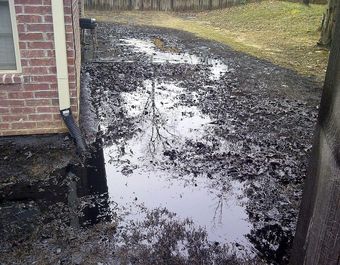 Oil
next to a home in Mayflower, Ark. As residents of
the tiny central Arkansas town were scrambling to
protect Lake Conway from a river heavy oil that was
flowing through their streets, ExxonMobil didn't
know what was happening, according to sheriff office
reports obtained by InsideClimate News. Credit: EPA
Oil
next to a home in Mayflower, Ark. As residents of
the tiny central Arkansas town were scrambling to
protect Lake Conway from a river heavy oil that was
flowing through their streets, ExxonMobil didn't
know what was happening, according to sheriff office
reports obtained by InsideClimate News. Credit: EPA
As residents and local officials of Mayflower, Ark. were scrambling to evacuate homes and protect their treasured fishing lake from a river of heavy oil pouring through their town on Good Friday afternoon, ExxonMobil, the company responsible for the accident, didn't know what was happening.
A 22-foot gash had opened up in its oil pipeline that cut through the Arkansas town, 450 miles from its headquarters in Houston, and the people were in a sudden uproar. In the emergency response, dispatchers called Exxon and informed them of the unfolding disaster, and company employees arrived on the scene an hour after the emergency was first reported to local authorities.
That is the picture that emerges from transcripts of 911 police reports obtained by InsideClimate News from the Faulkner County Sheriff's Office.
Police transcripts show that Jennifer Dement of 50 Starlite Road North was the first to report the oil spill at 2:44 p.m. on March 29.
"Caller adv that a pipe busted and oil is spilling throughout the neighborhood!!" the first entry says. From there, the transcripts show in terse entries how the emergency unfolded.
At the time of the initial calls, no one yet knew that it was Exxon's 65-year-old Pegasus pipeline running from Illinois to Texas that had burst or that it was Canadian heavy oil that was flowing down the streets. Nor did they know that to make the heavy oil flow through the pipeline, producers dilute it with toxic chemicals that evaporate when released into the environment, endangering the health and lives of people who inhale the fumes.
Within three minutes, three responders were dispatched to the scene, including the Mayflower Volunteer Fire Department. By 2:59 p.m., 15 minutes after the rupture was discovered, homes were being evacuated, and the transcripts note "the oil is spreading fast ... storm drain is backed up."
Ten minutes later, the hazardous materials team from the nearby town of Conway was contacted to help with containment of the spill, which was heading toward Lake Conway, a 6,700 acre man-made reservoir nine-tenths of a mile away from the accident. Heavy oil— ultimately at least 200,000 gallons and as many as 420,000 gallons—was still pouring through the tear in the pipeline and through the town.
It wasn't until 3:19 p.m. that the transcripts record first contact with Exxon.
"Exxon Mobil contacted and enroute/30 minute eta," the transcript notes.
Exxon company responders arrived within 24 minutes, and at 3:46 p.m. Exxon told local officials that they had shut off the pipe.
Responders kept arriving, railroads were backed up, and at 5:00 p.m. it began to drizzle, complicating the response.
The transcripts provide the first glimpse of how the pipeline rupture was discovered and how quickly it upended the lives of residents of the small Arkansas town of 2,200 people.
"That afternoon, we heard lots of sirens—and of course, you know being a small town, everybody wants to know what all the sirens are about—and then we started getting phone calls," Becky Naylor, a seventh generation resident of Mayflower told Living on Earth in a radio interview. "Everybody around, all the neighbors started calling one another and letting 'em know they've had a break in the pipeline that runs through the back.
"It look likes black mud. It's horrible. The smell is horrendous. ... On the days that it's not raining, and it gets a little warm, it'll almost take your breath away."
Exxon has maintained a studied silence on the events of the day, noting in press releases and communications with federal investigators that the company shut off the pipeline within 16 minutes of learning of the spill.
And while police reports indicate that Exxon found out about the spill when the company was notified by local officials, other documents suggest that the company may have known something was wrong hours earlier.
Exxon told the federal National Response Center that it saw a problem on the line at 1:15 p.m. when it spotted a drop in pressure, an hour and a half before the first 911 call reached the Faulkner County sheriff. The National Response Center is a division of the U.S. Coast Guard. Pipeline operators must notify the NRC of oil or chemical spills. Exxon placed that first call to the NRC at 4:06 p.m. local time, about 20 minutes after its responders arrived on the scene in Mayflower.
Two hours after filing that first report with the NRC, however, Exxon filed a second report reporting the time of the incident as 3:20 p.m. In a third report to the NRC the next day, Exxon again reported "the incident was discovered" at 1:15 p.m.
In an interview on Wednesday, Larry Hawthorne, the Exxon field regulatory specialist who made the first call to the National Response Center, said NRC made a "mistake" when it listed 1:15 p.m. He said the report should have said 3:15 p.m., because that's when an Exxon employee confirmed the spill on the ground. The police transcripts say Exxon did not arrive on the scene until 3:43 p.m.
Chris Mattice, an NRC senior watch officer, checked audio recordings of the calls on Wednesday night and told InsideClimate News the "reports as they are written are consistent with the audio recordings on file."
More on this article at: http://insideclimatenews.org/news/20130411/exxon-didnt-know-its-pipeline-ruptured-until-called-arkansas-authorities-or-did-it?page=2